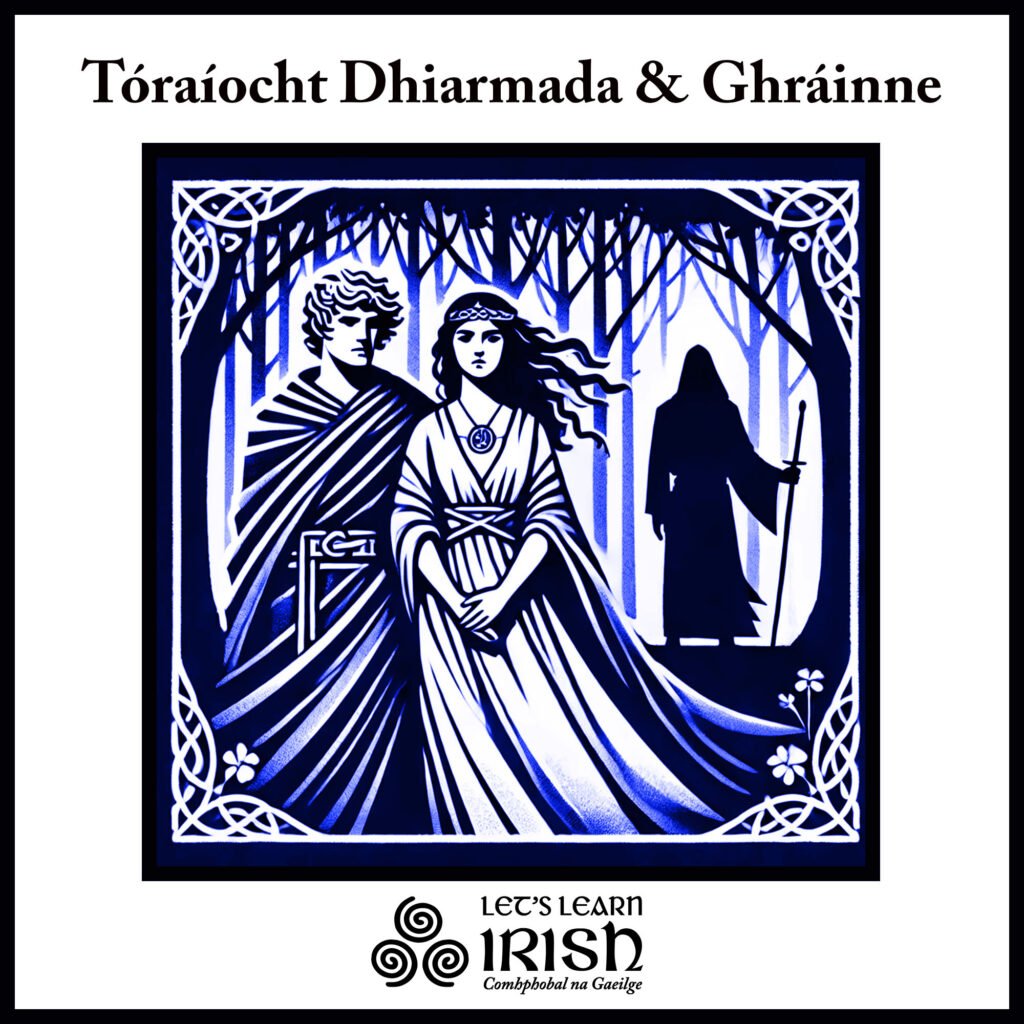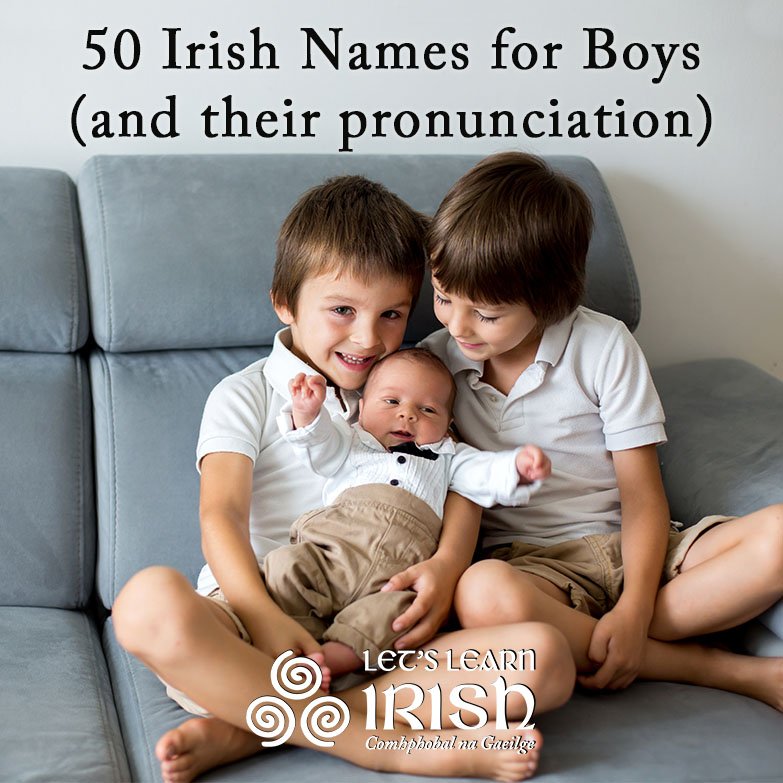Tóraíocht Dhiarmada agus Ghráinne

Many learners of Irish will be familiar with Tóraíocht Dhiarmada agus Gráinne, or The Pursuit of Diarmuid and Gráinne. For generations, the popular tale was on the Irish national school curriculum, and likewise an integral part of studying the language in online Irish courses and in classrooms across the world. In fact, it’s probably hard to learn Irish without running into these vexed lovers.
As Irish mythology confirms, the love triangle has long been a classic trope in storytelling. Tóraíocht Dhiarmada agus Gráinne, one of the major stories of the Fenian Cycle of ancient Irish texts, features the young and beautiful Gráinne eloping with her lover Diarmuid to avoid an arranged marriage to the aging king Finn mac Cumhaill. The epic involves an extensive chase in which the lovers are followed all over Ireland and Scotland, continually having to outsmart Finn and his warriors.
Although the earliest surviving text dates to the 16th century, some scholars believe that some parts of the story may go back as far as the 9th or 10th century. Since then, Tóraíocht Dhiarmada agus Gráinne has gone on to inspire adaptions and other stories centuries later, and even a dance show.

The Plot of Tóraíocht Dhiarmada agus Gráinne
Finn mac Cumhaill, leader of the warrior band the Fianna and central figure of the Fenian Cycle, was looking to remarry after the loss of his wife. Gráinne, the daughter of the high king Cormac mac Airt, was known to be the most beautiful woman of all of Ireland. She agreed to marry Finn, but then started to regret her choice due to his age. Instead, she had eyes for his warrior, Diarmuid.

During her wedding banquet, Gráinne spikes everyone’s drink, except Diarmuid’s. With only the two of them awake, she confesses her love to him and pleads for him to elope with her. Out of fealty to Finn, Diarmuid refuses, until Gráinne threatens him with a geis, a supernatural obligation that reoccurs in Irish mythology. Diarmuid relents and runs away with Gráinne, and, as the title suggests, is chased by Finn and his men across Ireland and Scotland.
After being flushed from one hideout to another, Diarmuid’s foster father Aengus Óg helps negotiate a truce with Finn mac Cumhaill, allowing the lovers to settle down in what is now modern-day County Sligo and produce five children. All is well, until Finn invites Diarmuid to a bear hunt. Incidentally, it had been prophesized that Diarmuid would die while hunting a bear, but he still felt obligated to accept Finn’s cuireadh (invitation).
On the hunt, Diarmuid is mortally wounded as he deals the deathblow to the bear. Finn has the supernatural powerful to heal Diarmuid by giving him water to drink from his hand, but twice Finn allows the water to run through his fingers. When finally forced to comply by his own garmhac (grandson), it is too late for Finn to save Diarmuid.

Sites Associated with the Tale
One of the most iconic locations associated with the tale is Benbulben, a large rock formation in County Sligo. According to legend, it is here that Diarmuid met his tragic end. The mountain itself is steeped in myth and is said to be one of the hunting grounds of the Fianna. The nearby Gleniff Horseshoe drive offers stunning views of the Dartry Mountains, including Benbulben. Local folklore holds that various caves and rocky outcrops here provided shelters to the fleeing lovers.

The Beara Peninsula is another place linked with this tale. It is said that Diarmuid and Gráinne spent some time hiding in the many secluded spots along this rugged coastline. Similarly, legend has it that the island at Lough Key Forest Park, in County Roscommon, was one of the many hideouts for the couple. The forest park, with its beautiful lake and lush woodlands, provides a picturesque setting that seems fitting for such a legendary tale.
As warned by Aengus Óg, the lovers couldn’t sleep in the same place twice during the toraíocht (chase). Accordingly, many leabaí, or beds, associated with Diarmuid and Gráinne are found all over the western side of Ireland. In actuality, these sites are Neolithic stone monuments that have been linked to the story by local populations. In particular, many of leaba are dolmans, which are burial portals consisting of a large flat rock on top of two supporting rocks. Examples can be found, among many other places, in the Burren in County Clare, Carickglass in County Sligo, Gorteen in County Mayo, and in Carrowmore—also in County Sligo, where the bones of Diarmuid and Gráinne are rumored to be buried. The legend has it that women who sleep on leaba are more likely to get pregnant, since a child was conceived during the pursuit of the couple.

Retellings of Tóraíocht Dhiarmada agus Gráinne
Perhaps one of the greatest measures of the impact that Tóraíocht Dhiarmada agus Gráinne has had in Irish culture is the number of adaptions that it has inspired. Likely the first major retelling was in the form of the 12th century Medieval tale Tristan and Isolde, in which an Irish princess and Cornish knight are pursued after an elicit love affair. There is also a parallel story in the Ulster Cycle, in which Deirdre is intended to marry the old king Conchobar mac Nessa, but instead runs away with her lover Naoise, ultimately to both of their demise.
The adaptations of the Irish epic have continued into modern day. Famed writers Y.B. Yeats and George Moore wrote the play Diarmuid and Grania in 1901, based on the translation by Lady Gregory. One hundred years later, Irish writer and director Paul Mercier also wrote a play based on the tale, and then turned it into a scannán (film) titled Pursuit in 2015. Mercier’s play and movie set the story in the criminal underworld of Dublin. The 1999 stage show “Dancing on Dangerous Ground” was a retelling of the story in dance, featuring Jean Butler, the famous female lead in Riverdance.

Tóraíocht Dhiarmada agus Gráinne has maintained, after all these centuries, an important part in the language and culture of Ireland. From school books to gritty movies, the lovers being chased across the Irish landscape has sparked the imagination of the Irish people and continues to be a story they hold dear. If there’s anything that we can learn from this old mythological tale, it’s that the Irish have always been good storytellers.
Bígí páirteach!
Join the online Irish community at LetsLearnIrish.com.
Follow on social media @LetsLearnIrish.





